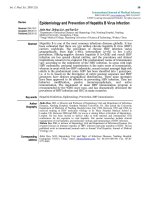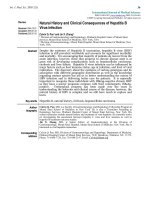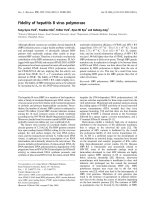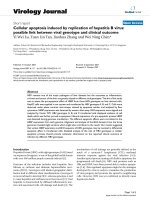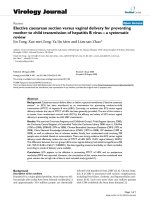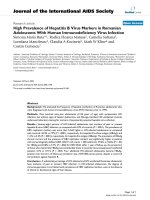A comprehensive proteome analysis of hepatitis b virus associated hepatocellular carcinoma
Bạn đang xem bản rút gọn của tài liệu. Xem và tải ngay bản đầy đủ của tài liệu tại đây (13.51 MB, 430 trang )
A COMPREHENSIVE PROTEOME ANALYSIS OF
HEPATITIS B VIRUS-ASSOCIATED HEPATOCELLULAR CARCINOMA
ZUBAIDAH BTE MOHAMED RAMDZAN
(B. Sc. (Hons.), NUS)
A THESIS SUBMITTED FOR THE
DEGREE OF DOCTOR OF PHILOSOPHY
DEPARTMENT OF BIOCHEMISTRY
NATIONAL UNIVERSITY OF SINGAPORE
2009
i
ACKNOWLEDGEMENTS
I would like to express my deep appreciation to my supervisor Associate Professor
Maxey Chung, for his invaluable guidance, advice and insightful discussions throughout
my university years and in this course of research. Prof. Chung has always been a
supportive mentor even prior to me joining his laboratory. I am also grateful for the
opportunities provided to learn, engage my curiosity and develop my passion in Science.
I am also indebted to all the members of the laboratory, endearingly named
“MaxProteomics” which I have since called my second family. Dr Sandra Tan for her
continuous encouragement readily provided throughout the entire project. Dr Lin
Qingsong for imparting his knowledge and the late evenings spent patiently explaining
technical details. A very big thank you to Cynthia, Gek San and Teck Kwang, the best
research assistants a student could wish for, for sharing their secrets for the perfect 2-D
gel and LC runs. I am also grateful to Siaw Ling and Eric for their bioinformatics support
and for kindly teaching me the basics.
I am deeply heartened by the many friendships forged in the lab, especially to Xuxiao,
Vincent and Hendrick for the many brainstorming (bickering) sessions, lab jokes and
their ever available support. I would also like to thank Hwee Tong and Yihao and ex-
labmates, Jason, Justin, Lifang, Jiayi and Hong Qing for their company, friendship, many
invaluable help and laughter that we have shared.
I would like to acknowledge Dr Lim Seng Gee, for kindly providing the tissue samples
for this project. I wish to also extend my thanks and gratitude to Shashi, Say Tin and staff
of Proteins and Proteomics Centre for their continuous support and the use of various
equipments. I am also deeply appreciative of the administrative assistance and numerous
professors from the Dept. of Biochemistry for their care and concern towards my well-
being. I am especially grateful to Special Programme in Science as well as Prof Alex Ip,
Prof Teo Tian Seng, Dr Kuldip Singh and Prof Michael David (UCSD) for instilling my
passion and love for research. I am also thankful to the students I had the privilege to
mentor for their constant “hows and whys” which kept me on my toes.
My friends Fazli, Xinyuan, Daryl, Jumilia, Pei Chin, Siew Ping, Zack, Aaron and Gerard
who spent the last many years listening to my complains and sharing my joys. I could not
have completed this thesis without their encouragements. Lastly my family; my father for
reminding me that no adversity will take me away from my dreams, my mother for her
constant prayers that I will not be swayed from my faith, my sisters: Nazimah, Yasmin
and Nisha for their unwavering love (and long distance phone calls) that never fails to
cheer me up and in ensuring that I continue to achieve my goals in life.
ii
TABLE OF CONTENTS
ACKNOWLEDGEMENTS I
TABLE OF CONTENTS II
SUMMARY X
INDEX OF TABLES XII
INDEX OF FIGURES XIII
INDEX OF ABBREVIATIONS XVIII
1. LITERATRUE REVIEW 1
1.1 Hepatocellular Carcinoma (HCC) 1
1.1.1 Epidemiology 1
1.1.2 Aetiological factors 1
1.1.2.1 Hepatitis B virus 2
1.1.2.2 Hepatitis C virus 4
1.1.2.3 Aflatoxins 5
1.1.2.4 Inherited disorders 6
1.1.3 Morphological changes in Hepatocarcinoma 6
1.1.3.1 Preneoplasia and Dysplasia 9
1.1.3.2 Neoplasia 10
iii
1.1.4 Staging of HCC 11
1.1.5 Diagnosis and treatment 14
1.1.5.1 Screening tests 15
1.1.5.2 Treatment 16
1.1.5.3 Prevention 17
1.1.6 Common molecular themes in HCC 18
1.1.6.1 Challenges in understanding HCC 18
1.2 “Omics” based biology in Hepatocarcinogenesis 20
1.2.1 Functional genomics in HCC 21
1.2.1.1 Chromosomal instabilities 21
1.2.1.2 Epigenetic alterations 22
1.2.2 Transcriptomics: gene expression profiling in HCC 23
1.2.3 MicroRNAs involvement in HCC 24
1.2.4 Proteomics 25
1.2.4.1 Proteome analysis of HCC cell lines 28
1.2.4.2 Proteomic approaches using animal models 29
1.2.4.2 Proteome analysis of HCC tissues 31
1.2.4.3 Proteome analysis of serological markers for HCC 38
1.3 Current perspective in HCC studies 40
1.3.1 Advantages and limitations of proteomic platforms 41
1.3.1.1 Proposed multiple proteomic approaches 42
2. AIMS OF THE STUDY 44
iv
3. MATERIALS AND METHODS 46
3.1 Materials 46
3.1.1 Hepatocellular Carcinoma Tissues 46
3.1.2 Cell lines 48
3.1.2.1 Cell culture media and reagents 48
3.1.3 Instruments and Equipments 48
3.1.3.1 Isoelectric Focusing (IEF) 48
3.1.3.2 SDS-PAGE 49
3.1.3.3 Liquid Chromatography 49
3.1.3.4 Mass Spectrometry 49
3.1.3.5 Transblotter 49
3.1.3.6 Centrifuges 50
3.1.3.7 Spectrophotometer 50
3.1.3.8 Scanners 50
3.1.4 General Chemicals and Reagents 50
3.1.5 Western Blot reagents 53
3.1.5.1 Antibodies 53
3.1.5.2 Detection System 54
3.1.6 Softwares and Databases 54
3.1.6.1 Image Analysis 54
3.1.6.2 MS Data Analysis 55
3.2 Sample preparation 56
3.2.1 Tissue sample preparation 56
v
3.2.2 Cell line sample preparation 56
3.2.2.1 Cell culture 56
3.2.2.2 Cell lysate preparation 56
3.3 2-dimensional gel electrophoresis (2-DE) 57
3.3.1 Isoelectric Focusing on IPG (Immobilized pH gradient) Strips 57
3.3.2 Second Dimension Sodium Dodecyl Sulphate – Polyacrylamide Gel
Electrophoresis (SDS – PAGE) 58
3.3.3 Vorum Silver Staining 59
3.3.4 Difference Gel Electrophoresis 59
3.3.4.1 Labeling with CyDye Flours 59
3.3.4.2 Protein visualization 63
3.3.4.3 Decyder image analysis 63
3.3.5 In-gel tryptic digestion 64
3.3.6 Mass Spectrometry Analysis and Database Search 65
3.4 Quantitative Proteomics using stable-isotope labeling technologies 66
3.4.1 cleavable Isotope Coded Affinity Tag (cICAT) labeling 66
3.4.2 isobaric Tag for Relative and Absolute Quantification (iTRAQ) labeling. . 67
3.4.3 Two-Dimensional Liquid Chromatography separation of labeled peptides. 67
3.4.4 Mass spectrometry analysis and Database search 68
3.4.4.1 cICAT-labeled samples 69
3.4.4.2 iTRAQ-labeled samples 69
3.4.4.3 Determination of cut-off threshold for fold change 70
3.4.4.4 Estimation of false positive rate to determine cut-off score. 71
vi
3.5 Bioinformatics annotation tools 72
3.6 FUBP siRNA transfection 73
3.6.1 Cell proliferation assay 73
3.7 Immunoblotting 74
4. RESULTS 76
4.1 Differential proteome analysis of HCC tissues 76
4.1.1 Difference gel electrophoresis (2-D DIGE) 76
4.1.2 Decyder Analysis and MALDI TOF/TOF MS 78
4.1.2 Stable-isotope labeling techniques 81
4.1.2.1 cICAT coupled to 2-D LC and MALDI TOF/TOF MS 81
4.1.2.2 iTRAQ coupled to 2-D LC and MALDI TOF/TOF MS 83
4.2 Identification of differentially expressed proteins 85
4.2.1 Summary of proteins identified 109
4.2.2 Common proteins identified in different techniques 110
4.3 Protein physiochemical and biological properties 112
4.3.1 Molecular weight and Isoelectric point 112
4.3.2 Hydrophobicity plot 115
4.3.3 Localization and biological functions 117
4.3 Biological functions of regulated proteins 119
4.4 Verification of protein regulation 123
vii
4.4.1 Western blotting 123
4.4.2 Over expression of FUSE binding protein (FUBP) 128
4.4.2.1 Mass spectra of FUSE binding protein (FUBP) 129
4.4.2.2 Over expression of FUSE binding protein (FUBP) 133
4.4.2.3 c-myc validation by western blot 134
4.5 In vitro study on FUBP 135
4.5.1 Optimization of concentration of siRNA 135
4.5.2 Effects of FUBP knockdown on c-myc levels 138
4.5.3 Effects of FUBP knockdown in cell viability 139
5. DISCUSSION 140
5.1 Protein expression of moderately- and poorly-differentiated HCC 140
5.1.1 Alterations of proteins from common pathways 141
5.2 Dysregulation of Metabolic Proteins 142
5.2.1 Glucose metabolism and oxidative phosphorylation 142
5.2.1.1 Alterations in glycolytic pathway 143
5.2.1.2 Over-expression of aldolase A but not liver specific aldolase B 146
5.2.1.3 Elevated levels of alpha-enolase 147
5.2.1.4 Tri-carboxylic acid (TCA) cycle 148
5.2.2 Lipid metabolism 151
5.2.3 Down-regulation of methylation cycle proteins 152
5.3 Oxidative stress in HCC 154
viii
5.3.1 Perturbation in iron homeostasis results in oxidative stress 154
5.3.2 Inactivation of scavenging mechanisms 155
5.3.3 Elevated heat shock protein and inflammatory response 156
5.3.3.1 Dysregulations of heat shock proteins 156
5.3.3.2 Up-regulation of glucose regulated proteins (GRPs) 157
5.3.3.3 Over expression of S100 proteins in only poorly differentiated HCC 159
5.4 Dysregulation of c-myc associated proteins 161
5.4.1 Central role of c-myc in HBV-associated HCC 161
5.4.2 Differentially expressed proteins governed by c-myc 166
5.4.2.1 Dysregulation of hnRNP protein family 166
5.4.2.2 Over-expression of nucleotide diphosphate kinase 167
5.4.2.3 Nucleophosmin 168
5.4.3 Far-upstream binding proteins (FUBPs) 169
5.4.3.1 Mechanism of FUBPs in regulating c-myc’s expression 169
5.4.3.2 Over-expression of FUBPs 170
5.4.3.3 Loss of FUBPs display preferential response 171
5.4.3.4 Other possible roles of FUBPs 172
6. CONCLUSION 175
REFERENCES 178
APPENDIX I 212
ix
APPENDIX II 217
APPENDIX III 220
LIST OF PUBLICATIONS 226
x
SUMMARY
Hepatocellular carcinoma (HCC) is the most common primary liver cancer with
more than half of the cases attributed to persistent viral infection by the hepatitis B or C
virus. To date, the exact molecular pathogenesis of HCC remains ambiguous. In this
study, proteomic based approaches were used to identify protein targets with the aim to
unravel the molecular pathogenesis of HCC. Three quantitative approaches, viz, 2-D
DIGE, cICAT and iTRAQ coupled with 2-D liquid chromatography were used to analyze
tumour lysates from moderately- and poorly-differentiated HBV-related HCC. To our
knowledge, this is the first study using 3 proteomic techniques to analyse HCC tissues
belonging to two different stages of differentiation.
In this study, a total of 163 and 181 proteins were found to be dysregulated in
moderately- and poorly-differentiated HCC tissues respectively, among which only 12
proteins were common between all three techniques. Disparity among identified proteins
was expected as it is known that each method has its inherent bias and limitation. A
subset of these proteins was also verified using western blots to independently confirm
the presence of the proteins identified by 2-D DIGE, cICAT and / or iTRAQ. These
proteins were further grouped according to their function as annotated by Gene Ontology
for the ease of analysis. The majority of affected proteins were those involved in
metabolism. Most significantly, we are able to observe increasing abrogation of these
metabolic pathways from moderately- to poorly-differentiated HCC. In addition, proteins
related to iron homeostasis and defense mechanisms were also shown to be severely
impaired. These indicate that the tumourigenic liver had lost its ability to perform its
basic metabolic and detoxification functions.
xi
Among the proteins identified, further analysis was conducted on a novel protein
family, far upstream binding proteins (FUBPs) that were identified by 2-D DIGE. The
over-expression of FUBPs in both stages of HCC are of particular interest due to their
transcriptional activity on the oncogene, c-myc. Interestingly, a large number of
dysregulated proteins identified were also c-myc associated proteins. In addition, c-myc
was also observed to be elevated in the tissues used in this study. It has generally been
accepted that c-myc plays an important role in HCC progression, especially in a viral
associated carcinogenesis. The exact activators and functions of c-myc, however remain
poorly understood. It is possible that FUBPs over-expression is responsible for elevated
c-myc levels. Preliminary experiment using FUBP siRNA transfection on Hep3B, a HBV
antigen positive liver cell line showed a decrease in cell viability. This effect was
however not observed in HepG2, a HCC cell line without HBV in the genome. We
therefore propose that the FUBP family of proteins may be one of the possible upstream
players that are involved in HBV-related HCC tumourigenesis.
xii
INDEX OF TABLES
Table 1.1:
The Okuda staging system for HCC (adopted from Okuda et al., 1985)
12
Table 1.2:
The TNM staging system adapted from Sobin et al., 1997
13
Table 1.3:
Common chromosomal alterations in HCC
22
Table 1.4:
Summary of current HCC literature review that employed proteomic
techniques
35
Table 3.1:
Clinical characteristics of patient samples used in this study
47
Table 3.2:
DIGE experimental design for moderately-differentiated HCC liver
tissues. A total of five paired samples were used. For each sample pair
triplicate gels were run, and which are represented by A, B and C
61
Table 3.3:
DIGE experimental design for poorly-differentiated HCC liver tissues.
A total of seven paired samples were used. For each sample pair
triplicate gels were run, and which are represented by A, B and C.
62
Table 3.4:
Concentration of primary and secondary antibody used
75
Table 4.1
Significantly regulated proteins in moderately-differentiated HCC as
identified by 2-D DIGE, cICAT and iTRAQ are summarized according
to their respective biological functions. Expression levels are
summarized by arrows; down and up arrows indicate down-regulation
or up-regulation respectively.
86
Table 4.2
Significantly regulated proteins in poorly-differentiated HCC as
identified by 2-D DIGE, cICAT and iTRAQ are summarized according
to their respective biological functions. Expression levels are
summarized by arrows; down and up arrows indicate down-regulation
or up-regulation respectively.
97
Table 4.3
Total number of proteins identified from each technique. 109
Table 4.4
Summary of FUBP1 and FUBP2 protein spots based on DeCyder
analysis.
132
xiii
INDEX OF FIGURES
Figure 1.1:
Illustration of the chronological sequence of hepatocellular lesions
leading to the development of HCC.
8
Figure 1.2:
Summary of the various sample, analysis and platforms available in a
proteomic study.
27
Figure 4.1:
Representative images of 2D-DIGE analysis (A) moderately differentiated
HCC and (B) poorly differentiated HCC tissues.
77
Figure 4.2:
Differentially expressed protein spots in the 2D gels are marked with
master numbers in (A) moderately-differentiated tumour tissues and (B)
poorly-differentiated tumour tissues. *Protein spots that are down-
regulated are in green and up-regulated proteins are in red.
79
Figure 4.3:
Representative mass spectra of 60kDa heat shock protein (HSP60)
analyzed by MALDI-TOF/TOF MS upon tryptic digestion. (A) MS
spectrum with tryptic peptides of HSP60 labelled by the cICAT heavy and
light reagents; arrow indicates ion at m/z = 1864.035 selected for MS/MS
(B) MS/MS spectrum of the peptide AAVEEHIVLGGGCALLR (m/z =
1864.035), where y- and b-ions are denoted along with immonium ions
(V, valine; L, leucine); y- and b-fragmentations are also indicated with
tilted dotted lines above and below the sequence, respectively.
82
Figure 4.4:
Representative iTRAQ mass spectra of 60kDa heat shock protein (HSP60)
analyzed by MALDI-TOF/TOF MS upon tryptic digestion. (A) MS
spectrum with tryptic peptides of HSP60; arrow indicates ion at m/z =
1503.8 selected for MS/MS (B) MS/MS spectrum of the peptide
NAGVEGSLIVEK (m/z = 1503.8), where y- and b-ions are denoted along
with immonium ions (V, valine; L, leucine); y- and b-fragmentations are
also indicated with tilted dotted lines above and below the sequence,
respectively. (C) Reporter ion region of MS/MS m/z 1503.8.
84
Figure 4.5:
Venn diagram of proteins identified from 2-D DIGE, cICAT and iTRAQ
approaches in (A) moderately differentiated HCC and (B) poorly
111
xiv
differentiated HCC. * denotes the presence of additional 2 proteins
identified in 2-D DIGE and iTRAQ techniques but are differentially
regulated
Figure 4.6:
Scatter plot of molecular weight (kDa) and isoelectric point (pI) of all the
proteins identified by (A) 2-D DIGE; yellow, (B) cICAT; green and (C)
iTRAQ ; red.
114
Figure 4.7:
Plots of the GRAVY values of all the proteins identified via (A) 2-D
DIGE, (B) cICAT (C) iTRAQ. Bars in darker grey hue indicate proteins
with positive GRAVY scores. The numbers in brackets indicate the total
number of proteins identified by each technique.
116
Figure 4.8:
Distribution of the identified proteins according to (A) cellular
localization and (B) biological functions based on GO consortium. (A)
moderately-differentiated HCC tissues and (B) poorly-differentiated HCC
tissues
118
Figure 4.9:
Distribution of the moderately and poorly differentiated proteins. (Proteins
that were identified in more than one technique or with multi-isoforms are
counted as a single / unique protein)
119
Figure 4.10:
Distribution of the biological functions of the common dysregulated
proteins from moderately- and poorly-differentiated HCC.
120
Figure 4.11:
Distribution of selected moderately and poorly differentiated proteins
according to KEGG and Gene Ontology biological functions. (Grey bars
represent proteins that are down-regulated; Black bars represents are up-
regulated proteins.)
122
Figure 4.12:
Verification of selected proteins using 1D western blot; (A) down-
regulated proteins, (B) up-regulated proteins and (C) housekeeping
proteins.
124
Figure 4.13:
Western blot images of nucleotide diphosphate kinase A (NDKA) of 6
representative tissues for moderately- and poorly-differentiated HCC
tissue lysates.
126
xv
Figure 4.14:
Silver colloidal membrane of 1D western blots representative 127
Figure 4.15
:
Representative image of ImageQuant and DeCyder analysis of (A)
moderately-differentiated HCC – 3 protein spots of FUBP1 977, 985 and
992 with average ratios of 3.65, 1.60 and 1.99 respectively, (B) poorly-
differentiated HCC – FUBP1 882 and 895 with average ratio of 1.68 and
1.90; FUBP2 681 and 694 with average ratios of 1.86 and 2.34. (N: non-
tumour, T: tumour ; Image view and 3-D view obtained from DeCyder)
129
Figure 4.16
:
Representative mass spectra of FUBP1 and FUBP2 analyzed by MALDI-
TOF/TOF MS upon tryptic digestion. (A) MS spectrum with tryptic
peptides of FUBP1; arrow indicates ion at m/z = 1336.70 selected for
MS/MS (B) MS/MS spectrum of the peptide IGGNEGIDVPIPR (m/z =
1336.69), where y- and b-ions are denoted along with immonium ions (G,
glycine; P, proline; V, valine; I, isoleucine; R, arginine); y- and b-
fragmentations are also indicated with tilted dotted lines above and below
the sequence, respectively. (C) MS spectrum with tryptic peptides of
FUBP2; arrow indicates ion at m/z 1184.72 selected for MS/MS and (D)
MS/MS spectrum of the peptide IINDLLQSLR (m/z = 1184.72), where y-
and b-ions are denoted along with immonium ions (I, isoleucine; L,
leucine; Q, glutamine; R, arginine); y- and b-fragmentations are also
indicated with tilted dotted lines above and below the sequence,
respectively.
130
Figure 4.17:
Western blot images of FUSE binding protein (FUBP1/2) of the 6
representative tissues for moderately- and poorly-differentiated HCC
tissue lysates.
133
Figure 4.18:
1-D Western blot images of c-myc of the 6 representative tissues for
moderately- and poorly-differentiated HCC tissue lysates. Equal loading
of proteins were confirmed in a colloidal stained membrane (data not
shown).
134
Figure 4.19:
1-D Western blot images of FUBP 1 / 2 / 3 and GAPDH on HepG2 whole
cell lysates following addition of 3 different concentration of siRNA, NTC
136
xvi
: non-targeting control, GAPDH, FUBP 1 / 2 / 3.
Figure 4.20:
1-D Western blot images of FUBP 1 / 2 / 3 and GAPDH on HepG2 whole
cell lysates following addition of 3 different concentration of siRNA, NTC
: non-targeting control, GAPDH, FUBP 1 / 2 / 3.
137
Figure 4.21:
1-D Western blot images of (A) HepG2 and (B) Hep3B upon FUBP 1 / 2 /
3 siRNA treatment. GAPDH levels are used as loading controls.
138
Figure 4.22
:
Cell viability were measured using absorbance value at 550nM upon
treatment of FUBP siRNA. All absorbance values were normalized to the
respective non-targeting controls (NTC). X-axis indicates the
concentration of siRNA used. Grey bars represent HepG2 cells and black
bars represent Hep3B cells.
139
Figure 5.1 :
Diagrammatic representation of glycolysis and the various dysregulated
enzymes. Enzymes that were identified in moderately- and poorly-
differentiated HCC are boxed in blue and red respectively. In addition,
enzymes that were over-expressed are in red and those that are down-
regulated are in black. (KHK, ketohexokinase; FBP, fructose-1,6
bisphosphatase; ALDO A / B, aldoalase A / B; TKT, transketolase; PGM,
phosphoglucomutase; ENO, alpha-enolase.)
144
Figure 5.2 :
Schematic representation of tri-carboxylic acid (TCA) cycle and
dysregulation of enzymes observed in both stages of HCC. Proteins
identified in moderately- and poorly-differentiated are in blue and red
boxes respectively. All the enzymes identified were down-regulated.
(ACO1, aconitate dehydrogenase; IDH1, isocitrate dehydrogenase;
SUCLG, succinyl-CoA ligase; SDHA, succinate drhydrogenase; FH,
fumarate hydratase).
150
Figure 5.3 :
Schematic illustration of the methylation cycle. Proteins identified in
moderately- and poorly-differentiated are in blue and red boxes
respectively. All the enzymes identified were down-regulated. (MAT,
methionine adonesyltransferase; BHMT, betaine homocysteine N-
methyltransferase; Adomet, adenosylmethionine).
152
xvii
Figure 5.4:
Schematic diagram illustrating the different proteins identified that
interacts with c-myc as annotated by Ingenuity Pathway Analysis (IPA).
Arrows are used to describe increasing expression and inhibitory
interactions are described using T-shape connectors. Protein-protein
bindings are represented by solid grey lines. In addition up-regulated
proteins that are identified in this study are in red and those down-
regulated are in green
164
Figure 6.1:
Schematic diagram illustrating the possible mechanisms that may be
involved in the amplification of the proto-oncogene, c-myc and HCC
tumourigenesis.
177
xviii
INDEX OF ABBREVIATIONS
1-D One-dimensional
2-DE Two-dimensional electrophoresis
2-D DIGE Two-dimensional difference gel electrophoresis
Acc. No. Accession number
aCGH Array-based comparative genomic hybridization
ACN Acetonitrile
AFB1 Aflatoxin B1
cDNA Complementary DNA
CHCA α-cyano-4-hydroxy-cinnamic acid
cICAT cleavable Isotope-coded affinity tag
CyDye Cyanine fluorescent dye
Da Dalton
DMSO Dimethyl sulfoxide
DNA Deoxyribonucleic acid
DTT Dithiothreitol
EDTA Ethylenediaminetetraacetic acid
FAP Familial adenomatous polyposis
FBS Fetal bovine serum
FISH Fluorescence in situ hybridization
FUBP Far upstream binding protein
xix
g Centrifugal force
GO Gene Ontology
GRAVY Grand average of hydropathicity
HBV Hepatitis B virus
HBsAg Hepatitis B surface antigen
HCV Hepatitis C virus
HCC Hepatocellular Carcinoma
HIF Hypoxia inducible factor
hr Hour(s)
HRP Horse radish peroxidise
IAA Iodoacetamide
IEF Isoelectric focusing
iTRAQ isobaric Tag for Relative and Absolute Quantitation
IPG Immobilized pH gradient
IPI International Protein Index
KEGG Kyoto Encyclopedia of Genes and Genomes
LCC Large cell change
LC-MS Liquid chromatography-mass spectrometry
LOH Loss of heterozygosity
MALDI-
TOF/TOF MS
Matrix-assisted laser desorption/ionization-tandem time-of-flight mass
spectrometry
min Minute(s)
xx
miRNA MicroRNA
M
r
Relative molecular mass
MS/MS Tandem mass spectrometry
MMTS Methyl methane-thiosulfonate
MTT 3-4,5-dimethylthiazolyl-2,5-diphenyl-tetrazolium bromide
MW Molecular weight
NaB Sodium butyrate
NH
4
HCO
3
Ammonium bicarbonate
NNM N-nitrosomorpholine
PCR Polymerase chain reaction
PBS Phosphate buffered saline
pI Isoelectric point
PTM Post-translational modification
RNA Ribonucleic acid
ROS Reactive oxygen species
rpm Revolutions per minute
s/n Signal to noise
SAGE Serial analysis of gene expression
SCC Small cell change
SDS-PAGE Sodium dodecyl sulphate-polyacrylamide gel electrophoresis
SELDI Surface enhanced laser desorption and ionization
SEREX Serological analysis of antigens by recombinant expression cloning
xxi
SILAC Stable isotope labeling by amino acid in cell culture
siRNA Small interfering RNA
TAA Thioacetemide
TBS-T Tris buffered saline – Tween
TCEP Tris-(2-carboxyethyl) phosphine
TFA Trifluoroacetic acid
TOF Time of flight
UniProt Universal Protein Resorce database ()
v/v Volume / Volume
w/v Weight / Volume
1
1. LITERATRUE REVIEW
1.1 Hepatocellular Carcinoma (HCC)
1.1.1 Epidemiology
Hepatocellular carcinoma (HCC) is the most common primary liver cancer. Globally
HCC ranks fifth amongst the most common cancers but it is the third leading cause of cancer
death with an estimated one million death annually (Bosch et al., 2004; Cha and DeMatteo,
2005). It has a high fatality ratio with most patients who develop liver cancer dying within a
year (Yuen et al., 2009).
HCC has a wide geographical variability with the highest incidence in developing
nations, such as Asia and sub-Saharan Africa, accounting for 80% of new cases (Parkin, 2006;
Wong and Ng, 2008). In Southeast Asia, HCC is the second most fatal cancer since the 1970s
with a male predominance of 2 to 4 times more than for females (El-Serag and Rudolph, 2007).
Over the last 2 decades, there has also been a noticeable increase of HCC in developed
countries such as Europe and the United States (El-Serag and Mason, 1999; Zucman-Rossi and
Laurent Puig, 2007).
In Singapore, HCC is the fourth most frequently occurring cancer in men with an
overall incidence of 18.9 per 100 000 person-year (Singapore Cancer Society). The incidence is
highest among the Chinese population compared to the other ethnic groups (Yuen et al., 2009).
1.1.2 Aetiological factors
The risk factors of HCC have been well established. These include persistent hepatitis B
or C virus (HBV or HCV) infection, cirrhosis and aflatoxin B1 which accounts for almost 80%
2
of all HCC cases (Bosch et al., 2005; Thorgeirsson et al., 2006). Other aetiological factors
include severe alcohol abuse leading to cirrhosis (Stickel et al., 2002; Morgan et al., 2004),
smoking, as well as abnormal levels of oestrogen and androgen (Seow et al., 2001). In addition,
metabolic abnormalities such as hereditary haemochromatosis (Kowdley, 2004), α-1-antitrypsin
defiency, hereditary tyrosinaemia and Wilson’s disease can also lead to HCC.
In recent years, diabetes and obesity have also been identified as probable risk factors
for HCC (Polesel et al., 2009). HCC, due to obesity, most likely progresses through
steatohepatitis disease to cirrhosis and eventually carcinogenesis (Calle et al., 2003). It should
also be noted that the risk of HCC increases in the event of multiple risk factors.
1.1.2.1 Hepatitis B virus
Hepatitis B virus (HBV) is a 3.2kb partially double stranded DNA virus which can
cause an acute and chronic inflammatory response from the liver. The estimated number of
HBV chronic carrier world-wide is 400 million, of which 75% reside in Asia (Lai et al., 2003).
This incident level correlates strongly with the incidence of HCC. HBV is the first human virus
proven to cause cancer (Parkin, 2001; Beasley, 2009). In Singapore alone, a third of HCC
patients are HBV positive (Yuen et al., 1999). Further evidence has shown that patients who are
seropositive with chronic HBV infection are about 70-fold more likely to develop HCC (Rabe
et al., 2001). Numerous human HCC studies have also shown integrated HBV DNA sequences
and expression of viral proteins from these sites (Matsubara and Tokino, 1990; Su et al., 1998).
HBV infection consists of a replicative phase which results in prolonged cycles of liver
cell damage followed by regeneration of the hepatocytes and inflammatory processes. This
3
leads the development of chronic hepatitis, liver fibrosis and cirrhosis that may eventually
develop to HCC (Li et al., 2004; Kao et al., 2005). HBV-related HCC has also been observed in
non-cirrhotic liver background. In addition the viral genome has also been identified in the
early stages of tumourigenesis, suggesting that its integration precedes HCC development
(Brechot, 2004). This implies the possibility that the HBV viral genome may have some
intrinsic hepatocarcinogenic properties. The genomic alterations that occur as a result of viral
integration may therefore be an additional mechanism that causes HCC (Matsubara and Tokino,
1990).
The viral integration is a dynamic process and rearranges as hepatocytes proliferate.
This integration can cause cis- or trans-activiation and has been observed to affect a variety of
genes involved in proliferation, cell viability and cell signalling (Rabe et al., 2001). Possible
transactivators of the virus include truncated preS2/S, hepatitis B spliced protein and HBV-X
protein (Caselmann, 1995; Brechot, 2004; Tang et al., 2006). At least one of these sequences
has been identified in more than 80% of HBV-related HCC (Schluter et al., 1994).
The most studied candidate, HBV-X protein transactivating function was first
hypothesized by Miller and Robinson (1986). In vivo studies have shown that HBV-X is able to
transactivate a large number of promoters related to inflammation and cell proliferation through
protein-protein binding. This thus improves the cellular environment for further viral replication
(Tang et al., 2006). HBV-X is also able to increase sensitivity to possible carcinogens or
directly affect cellular oncogene levels such as c-myc (Yang et al., 2008) or inactivate tumour
suppressors such as p53 (Ueda et al., 1995). It can also modulate protein degradation via
proteosome regulation (Brechot, 2004) and stabilization of hypoxia inducible factor (HIF)
(Moon et al., 2004). Elevated levels of HIF have been observed during hypoxia conditions
